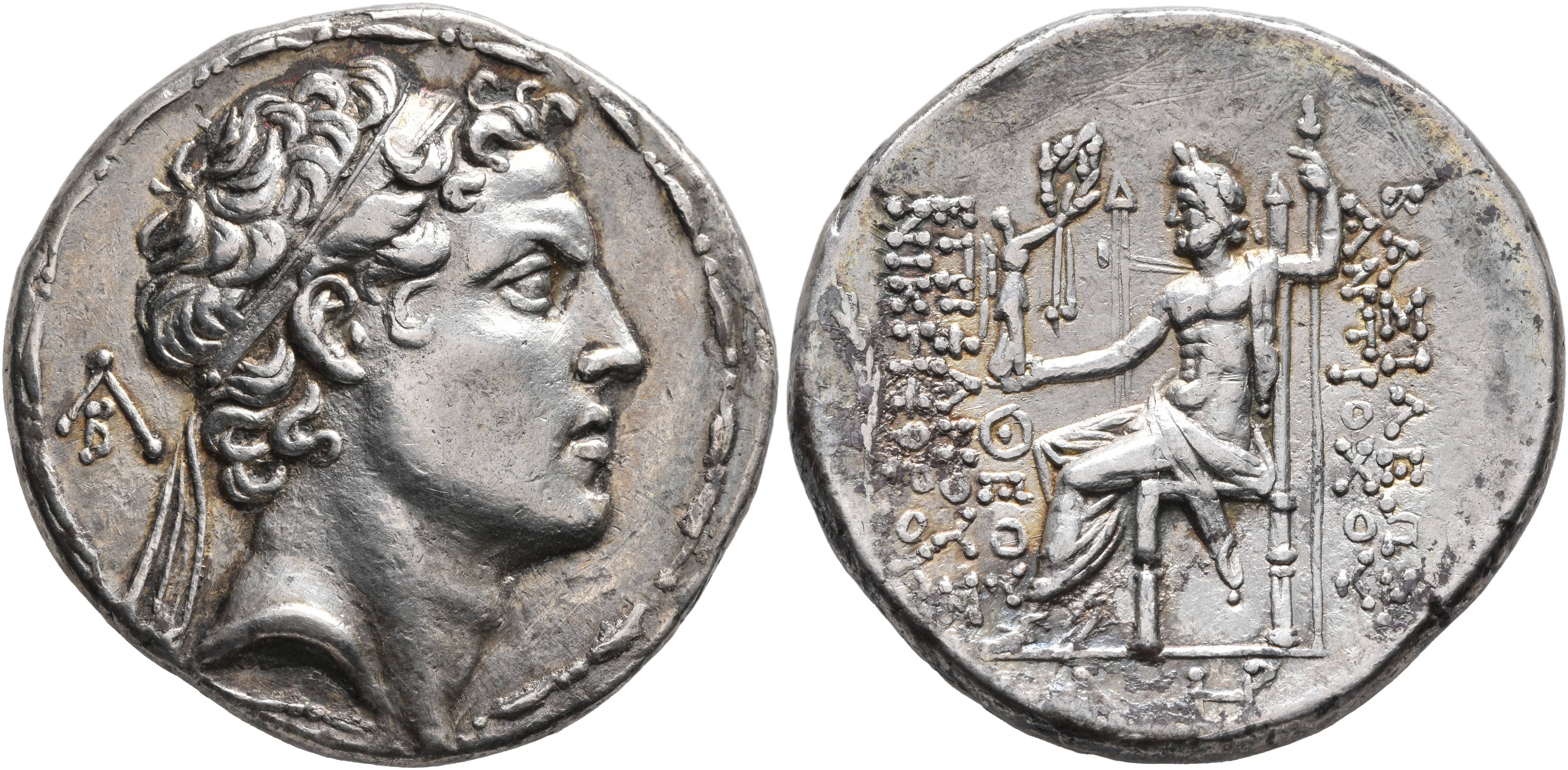Ptolemais-Ake (Antiochus IV), silver, tetradrachms (167-164 BCE) Voulgaridis
From SILVER
167 BCE - 164 BCE Silver 5,257 kg
Description
| ObverseInscription or printing placed on the obverse.: | Diademed head of Antiochos IV to right, behind, monogram of AB |
| ReverseInscription or printing placed on the reverse.: | BAΣIΛEΩΣ / ANTIOΧOY - ΘEOY / EΠIΦANOYΣ / NIKHΦOPOY (Greek).Zeus seated left, holding Nike in his right hand and long scepter in his left, to outer left, palm branch, in exergue, monograms of AB and HP |
Mint and issuing power
| MintIdentifies the place of manufacture or issue of a numismatic object.: | Ptolemais-Ake | Ancient regionAncient region.: | Phoenicia | Modern countryModern country: Israel | AuthorityIdentifies the issuing power. The authority can be "pretended" when the name or the portrait of X is on the coin but he/she was not the issuing power. It can also be "uncertain" when there is no mention of X on the coin but he/she was the issuing power according to the historical sources: | Antiochus IV Epiphanes (Seleucid king, 175-164 BC), Seleucid Dynasty (312-63 BC) |
Chronology
| FromIdentifies the initial date in a range assigned in a numismatic context. | 167 BCE | toIdentifies the final date in a range assigned in a numismatic context.. | 164 BCE | PeriodTime period of the numismatic object.: Hellenistic 323-30 BC |
Physical description
| MetalThe physical material (usually metal) from which an object is made.: | Silver |
Median weightMedian of the weights of numismatic objects (in grams). in grams | 17.10 | DenominationTerm indicating the value of a numismatic object. Examples: tetradrachm, chalkous, denarius.: | tetradrachm |
StandardStandard.: | Attic |
Image

S2006 Ptolemais Antiochus IV.jpg [1]
References
| Die study referencePublication of the study: | Voulgaridis 20001Voulgaridis 2000, p. 22-31 | ||
| Coin series referenceReference to coin series study: | SC II2SC II, n° 1476, HGC 93HGC 9, n° 620 | ||
Obverse dies distribution
| FrequencyFrequency of specimen in distribution. ᵖ | Number of obversesNumber of obverse dies. ᵖ (o) | % (o) | Number of coinsNumber of coins. (n) | % (n) | Die nameName(s) of the die(s). |
| 1 | 1 | 6.67 | 1 | 0.74 | 14 |
| 2 | 1 | 6.67 | 2 | 1.47 | 12 |
| 3 | 2 | 13.33 | 6 | 4.41 | 8, 15 |
| 5 | 1 | 6.67 | 5 | 3.68 | 1 |
| 6 | 1 | 6.67 | 6 | 4.41 | 11 |
| 7 | 1 | 6.67 | 7 | 5.15 | 2 |
| 8 | 2 | 13.33 | 16 | 11.76 | 10, 13 |
| 13 | 2 | 13.33 | 26 | 19.12 | 5, 9 |
| 14 | 1 | 6.67 | 14 | 10.29 | 3 |
| 16 | 1 | 6.67 | 16 | 11.76 | 4 |
| 17 | 1 | 6.67 | 17 | 12.5 | 6 |
| 20 | 1 | 6.67 | 20 | 14.71 | 7 |
| Total | 15 of 15 | 100.02 | 136 of 136 | 100 |
Reverse dies distribution
no distribution is available
Quantification
| Number of obversesNumber of obverse dies. ᵖ (o) | 15 | Number of singletons (o1)The number of singleton coins. ᵖ | 1 |
| Number of reverse diesNumber of reverse dies. (r) | 107 | Number of coinsNumber of coins. (n) | 136 |
| Coins per obverse dieNumber of coins per obverse die. (n/o) | 9.07 | Coins per reverse dieNumber of coins per reverse die. (n/r) | 1.27 |
| Reverse per obverse ratioRatio of obverse dies divided by reverse dies. (r/o) | 7.13 | Percentage of singletons (o1)number of coins (n) divided by the number of singletons (o1) ᵖ | 6.67 % |
| Original number of dies (O) (Carter 1983 formula)The estimation of the number of coins according to Carter 1983 ᵖ | 15.37 | Coins struck if 20,000 as average productivity per dieCoins made if the average productivity for obverses (according to Carter) is 20,000. ᵖ | 307,400 |
| Original number of dies (O) (Esty 2011 formula)The estimation of the number of coins according to the singleton formula in Esty 2011 ᵖ (O) | 16.86 | Survival rate if 20,000 as average productivity per dieSurvival rate if average productivity is 20,000. ᵖ | 0.00044 |
| Coverage (o = % of O) (Esty 1984 formula)Esty 1984 - coverage (% of O) ᵖ (o = % of O) | 99.26% | Die productivity if survival rate 1/2,000Average productivity if survival rate is 1/2,000. ᵖ | 17,696.81 |
| Weight of silver (in kg) if 20,000 coins per die (O = Carter formula)Carter 1983 * Median weight * 20000 (*10 if gold or electrum) ᵖ | 5,257 kg <br /> 5,257 kg | Die productivity if survival rate 1/5,000Average productivity if survival rate is 1/5,000. ᵖ | 44,242.03 |
Remarks
Most likely two workstations